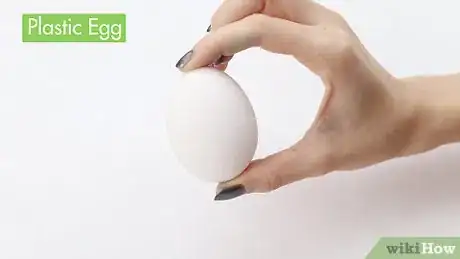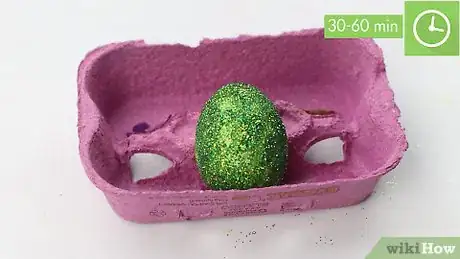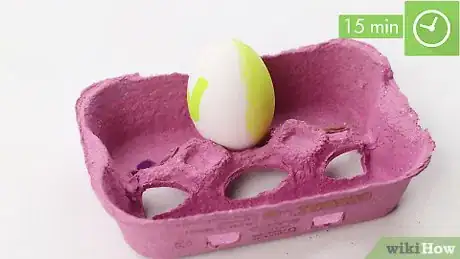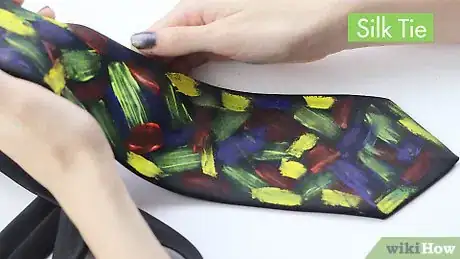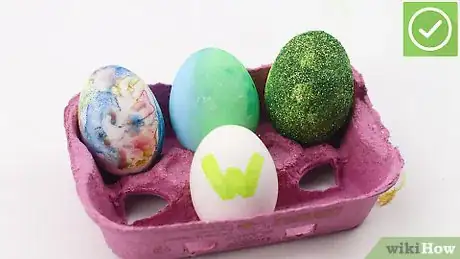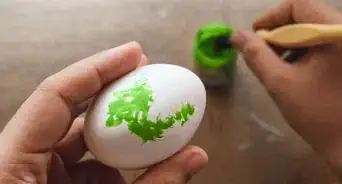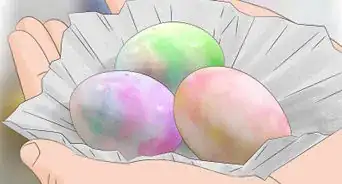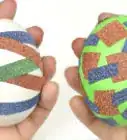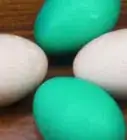This article was co-authored by wikiHow Staff. Our trained team of editors and researchers validate articles for accuracy and comprehensiveness. wikiHow's Content Management Team carefully monitors the work from our editorial staff to ensure that each article is backed by trusted research and meets our high quality standards.
There are 11 references cited in this article, which can be found at the bottom of the page.
The wikiHow Video Team also followed the article's instructions and verified that they work.
This article has been viewed 270,000 times.
Learn more...
Decorating Easter eggs is a fun activity that you can do with kids. There are a lot of ways to make the eggs colorful without sticking to a traditional kit. When working with art supplies, always work with hard-boiled eggs. After ten minutes on the stove and some cool-down time, you're ready! Assemble your materials and get started.
Steps
Dyeing Easter Eggs
-
1Boil the eggs. Put the eggs in a pan of water. Turn the heat to medium. Allow the eggs to boil for about fifteen minutes. Then, remove the eggs and allow them to cool.[1]
- While the eggs are boiling, use that time to cover the area where you will be dyeing the eggs with newspaper or paper towels.
-
2Fill a container. If you’re only dyeing one egg, you can use a cup (236.6 ml). For several eggs, you should use a larger, plastic container. Fill the container with a ½ cup of water, one teaspoon of white vinegar, and about twenty drops of any food color. You will know that you’ve used liquid if the egg completely submerges in the water.[2]
- Fill several containers if you will be using different colors. Each color should have its own container.
Advertisement -
3Soak the egg for 5 minutes. Place the egg on a spoon and dunk the egg into the liquid. Turn the egg around so that both sides get color. Allow the egg to soak for five minutes. Leave the egg longer if you’d like a darker color.[3]
-
4Dye the egg in multiple colors. You can dye the egg at least two colors by dipping only one section of the egg in at a time. This works best if you start with a fresh, boiled egg that has not been dyed yet. Hold one-half of the egg so that only half of it is submerged in the dye. After about five minutes, submerge the other half of the egg in another color.
- You will probably have to hold the egg as it soaks to submerge only half of it.
-
5Remove the egg. You can use tongs to gently remove the egg. Put the egg(s) in an egg carton to dry. The egg is now ready to be used for decoration.[4]
Making Glitter Eggs
-
1Use a plastic egg. Real eggs are difficult to use with this method because they break easily. A plastic or paper mache egg is best to use. You can use any color egg you’d like.[5]
-
2Paint the egg. You don’t have to paint the egg if it’s already the same color as the glitter you will be using. If it isn’t, choose a color of acrylic paint that is the same color as your glitter. Use a paint or sponge brush to coat the egg with two or three layers of paint. Wait until the egg completely dries to move on.[6]
-
3Apply Mod Podge. Use a separate sponge brush to apply a thick coat of mod podge to the egg. Make sure all of the egg gets covered with the Mod Podge. This part will be messy, and your fingers will likely get covered with glue.[7]
- You can use baby wipes to get the glue off of your fingers.
-
4Pour glitter over the egg. Put the egg into a plastic cup. The narrowest part of the egg should be facing upward. Pour glitter over the egg. Gently shake the cup so that the glitter covers the egg. You can add more glitter if necessary.
-
5Allow time to dry. Once the egg is coated in glitter, give it thirty to sixty minutes to dry. You can leave the egg in the cup as it dries, or place it in an egg carton.[8]
Painting the Eggs
-
1Boil the eggs. Hardboil the eggs for fifteen minutes. Allow the eggs to cool completely. Set them in the fridge if you'd like to speed up the process.[9]
-
2Use acrylic paint. Acrylic paint is ideal for eggs because it covers them well and adheres nicely. You can use any brand and color of acrylic paint that you’d like. Use a paintbrush to create fun designs. Since eggs are pretty small, get some fine-pointed paint brushes for more intricate designs.[10]
- You may want to cover the area where you will be painting with newspaper.
-
3Paint one half of the egg at a time. You can paint any design you want. You can leave it one color, paint geometrical patterns and shapes, or turn the egg into a cute animal—like a bird. Let it dry before painting the other half to avoid smearing the paint.[11]
-
4Create a sponged effect. You can use this technique if the egg has been painted one, solid color. Wait until the first layer of paint dried. Then, use a dry sponge to apply white paint on the eggs after the other paint dries. Don’t use a lot of paint. Use a thin layer of white paint and dab the sponge all over the eggs.[12]
-
5Allow the eggs to dry. Wait ten or fifteen minutes for the eggs to dry. Handle them carefully when you move them. Display your Easter eggs as you wish.[13]
Using Old Ties
-
1Find a silk tie. Use a tie that you won’t be wearing anymore. The tie should be 100% silk. A tie made of any other material won’t work. Choose a tie that has an interesting pattern. Dark purple, blue, and red ties work the best.[14]
- It doesn't necessarily have to be a beautiful tie. “Uglier” ties sometimes make the most beautiful eggs.
- If you don't have any ties laying around, silk ties can be found cheap at most thrift shops.
-
2Cut up the seam. This should double the size of your tie, which will give you a piece large enough to work with. Cut out a section that can easily wrap around your egg. You'll need a section of the material that wraps around the egg and can be held together. Leave about five centimeters of excess fabric.[15]
-
3Wrap your egg. Wrap the egg in the tie. The right side of the tie material (the side you would see if you were wearing it) should directly touch the egg. Wrap the egg as tightly as possible without breaking the egg.[16]
- The folds in the fabric will form a swirly pattern.
-
4Secure with a tie. Use a twisty tie to secure the fabric at the top of the egg. A string works, too, but a twisty tie is much easier to work with. Secure on the long side of the egg if you want the opposite end of the egg to show the pattern the best. Tie the egg horizontally if you want the wide side of the egg to show the design.[17]
-
5Wrap the egg with a second layer. Use a lightweight and lightly colored fabric. You can use a pillowcase, thin dishcloth, or sheet. Wrap the fabric tightly around the egg, and secure it with another twisty tie.[18]
-
6Boil the egg. Put the egg in a pot. Cover it with water. Add 1/4 cup (50 g) of vinegar. Boil for about 20 minutes. Then, take them off the heat and put them in a colander or on a towel to dry.[19]
-
7Allow them to cool. Give them about ten minutes to cool down before you touch them. Then, remove the fabric. Be careful when handling freshly dyed eggs.[20]
-
8That's it! Be creative and give free rein to your imagination as you make more eggs.
Community Q&A
-
QuestionI am entering an Easter egg decorating competition. What can I do to win?
 Community AnswerThe judges in Easter egg competitions are often impressed with precise pictures. They are also impressed by cute or unique designs as well. Avoid using egg-painting kits that you'd find in a grocery store, however.
Community AnswerThe judges in Easter egg competitions are often impressed with precise pictures. They are also impressed by cute or unique designs as well. Avoid using egg-painting kits that you'd find in a grocery store, however. -
QuestionCan you use any material other than a tie?
 Community AnswerYou can use another silk material. It just needs to be silk.
Community AnswerYou can use another silk material. It just needs to be silk. -
QuestionCan you use Sharpies (permanent markers) to write on eggs? Should it be done before or after you dye the egg?
 Community AnswerYes, you can use Sharpies. The metallic Sharpies on a solid color of dye produce a gorgeous effect. Try adding it before and after to find the best effect, as the dye color and pattern will affect its outcome. However, usually adding after makes the best sense.
Community AnswerYes, you can use Sharpies. The metallic Sharpies on a solid color of dye produce a gorgeous effect. Try adding it before and after to find the best effect, as the dye color and pattern will affect its outcome. However, usually adding after makes the best sense.
Warnings
- Do not plan on eating the eggs you decorate unless you can confirm that you did not use toxic materials to decorate your eggs.⧼thumbs_response⧽
Things You’ll Need
- Eggs
- Pan of water
- Glue
- Crayons
- Dye
- Acrylic paint
- Brush and sponge
- Scissors
- Food coloring
- Old ties
- Light material
- Pot
- Vinegar
- Twisty ties
- Towel or colander
- Scissors
- Glitter
- Mod Podge
- Plastic cup
References
- ↑ https://www.realsimple.com/holidays-entertaining/holidays/more-holidays/dye-easter-eggs
- ↑ https://www.realsimple.com/holidays-entertaining/holidays/more-holidays/dye-easter-eggs
- ↑ https://www.realsimple.com/holidays-entertaining/holidays/more-holidays/dye-easter-eggs
- ↑ https://www.realsimple.com/holidays-entertaining/holidays/more-holidays/dye-easter-eggs
- ↑ http://www.twosisterscrafting.com/glitter-easter-eggs/
- ↑ http://www.craftaholicsanonymous.net/glitter-eggs-tutorial
- ↑ http://www.craftaholicsanonymous.net/glitter-eggs-tutorial
- ↑ http://www.craftaholicsanonymous.net/glitter-eggs-tutorial
- ↑ https://www.realsimple.com/holidays-entertaining/holidays/more-holidays/dye-easter-eggs
- ↑ https://tipjunkie.com/easter-egg/
- ↑ https://tipjunkie.com/easter-egg/
- ↑ http://freestuff4kids.net/13-creative-ways-to-dye-and-decorate-easter-eggs/8/
- ↑ http://www.ebay.com/gds/How-to-Paint-Easter-Eggs-Like-a-Pro-/10000000177940981/g.html
- ↑ http://ourbestbites.com/2012/03/silk-dyed-eggs-aka-tie-dyed/
- ↑ http://ourbestbites.com/2012/03/silk-dyed-eggs-aka-tie-dyed/
- ↑ http://ourbestbites.com/2012/03/silk-dyed-eggs-aka-tie-dyed/
- ↑ http://ourbestbites.com/2012/03/silk-dyed-eggs-aka-tie-dyed/
- ↑ http://ourbestbites.com/2012/03/silk-dyed-eggs-aka-tie-dyed/
- ↑ http://ourbestbites.com/2012/03/silk-dyed-eggs-aka-tie-dyed/
- ↑ http://ourbestbites.com/2012/03/silk-dyed-eggs-aka-tie-dyed/
About This Article
Before decorating Easter eggs, hard boil the eggs by boiling them for 15 minutes, then letting them cool. Once your eggs are ready, fill a bowl with 1/2 cup of water, one teaspoon of vinegar, and 20 drops of food coloring. Next, put the egg in the bowl and let it soak for 5 minutes. Remove it when it’s the color you want, then let it dry in a carton. To add glitter to your eggs, spread some mod podge onto them with a small brush, then sprinkle the glitter over them and let it dry. Keep reading the article if you want to learn how to paint your Easter eggs!
